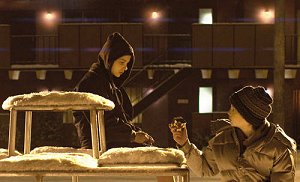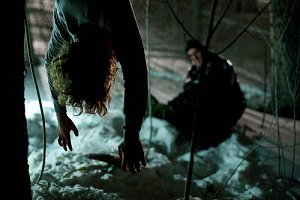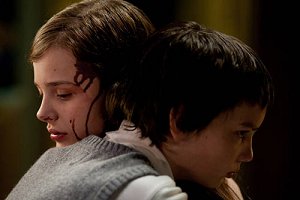 |
|
At The Picture Show
|
October 2010
Innocence lost
'Let Me In' is an evocative - if overly faithful - update of Swedish vampire classic

Let Me In
Overture Films
Director: Matt Reeves
Screenplay: Matt Reeves, based on the novel and 2008 screenplay (Let the Right One In) by
Johan Ajvide Lindqvist
Starring: Kodi Smit-McPhee, Chloe Grace Moretz, Richard Jenkins, Elias Koteas, Cara Buono,
Dylan Minnette and Ritchie Coster
Rated R / 1 hour, 55 minutes
Opened October 1, 2010


 (out of four)
(out of four)
We can sit here all day debating the merits of remaking a movie in the first place, much less one
that just came out two years ago, much less when the remake is so faithful to the original as to
render itself ultimately pointless.
But to engage in that discussion would, in this case, detract from the fact that Matt Reeves' Let
Me In - based on Tomas Alfredson's stellar Let the Right One In - belongs in the upper echelon
of English-language remakes of popular foreign films, my thoughts on that particular trend
notwithstanding. It doesn't quite stand on its own two feet - too many shots and lines of
dialogue are lifted directly - but it is an impressive and skillfully made exercise in low-key
horror.
 Only, to be honest, "horror" is the wrong word for it. Like its
predecessor, Let Me In is a movie about isolation couched in a mythological pop-culture motif
(vampires). Naturally, the mere mention of the word conjures thoughts of carnage and gore, but
here the violence isn't in service to itself, but completely germane to our understanding of the
two central characters. First there's Owen (Kodi Smit-McPhee), a 12-year-old boy living with
an inattentive mother in an isolated New Mexico town circa 1983. Then there's his mysterious
new neighbor, Abby (Chloe Grace Moretz), who appears to be a girl of about his age but in fact
is something quite different. ("I've been 12 years old for a very long time . . .")
Only, to be honest, "horror" is the wrong word for it. Like its
predecessor, Let Me In is a movie about isolation couched in a mythological pop-culture motif
(vampires). Naturally, the mere mention of the word conjures thoughts of carnage and gore, but
here the violence isn't in service to itself, but completely germane to our understanding of the
two central characters. First there's Owen (Kodi Smit-McPhee), a 12-year-old boy living with
an inattentive mother in an isolated New Mexico town circa 1983. Then there's his mysterious
new neighbor, Abby (Chloe Grace Moretz), who appears to be a girl of about his age but in fact
is something quite different. ("I've been 12 years old for a very long time . . .")
While her true nature is unknown to Owen, we discover that she is a vampire quite early on -
and that she moves from place to place because her "father" (Richard Jenkins) kills on a semi-nightly basis in order to satisfy Abby's voracious (if reluctant) thirst. (Leaving too many dead
bodies lying around in one place is a good way to attract suspicion.)
When the father can't procure her fix, Abby instinctively gets the job done on her own - without
regard for subtlety.
 But Abby isn't the only one with violent tendencies. Owen, frail
and innocent, seems to have developed a propensity for violence as well, largely stemming from
the daily abuse he takes from the other (bigger) kids in his class. So far, the darkness inside him
has only manifested itself in private - and even then, there seems to be fear and desperation
behind it, not bloodlust.
But Abby isn't the only one with violent tendencies. Owen, frail
and innocent, seems to have developed a propensity for violence as well, largely stemming from
the daily abuse he takes from the other (bigger) kids in his class. So far, the darkness inside him
has only manifested itself in private - and even then, there seems to be fear and desperation
behind it, not bloodlust.
In the film's terms (and, again, this goes back to Let the Right One In), violence is something
that is seen as genuinely threatening, even when it's necessary. (Then again, just because it's
threatening doesn't mean it's not also cathartic - a point made quite explicitly in a key scene.)
But it is embraced in sadness rather than excitement, and by two people - both of whom,
physically, exude angelic qualities - who are in the dark as to why things are the way they are.
That they come to form a bond is a result of a shared alienation, a need for someone - just one
person - to understand them without having to ask questions. There's a great shot of Owen
framed against his bedroom wallpaper, a desolate backdrop of the moon, with Earth a tangible
but distant object. Maybe that "Earth" will never be attainable for Owen, but with another soul
in tow, maybe the Moon won't be quite so desolate anymore.
 What made Let the Right One In so exceptional is the way it
used the vampire element as a tragic reflection of Owen's own struggles and, by proxy, the
isolation of childhood in general. The childlike appearance of the vampire (named Eli in the
original, and a bit more androgynous than Let Me In's Abby) is much more than a convenient
storytelling choice.
What made Let the Right One In so exceptional is the way it
used the vampire element as a tragic reflection of Owen's own struggles and, by proxy, the
isolation of childhood in general. The childlike appearance of the vampire (named Eli in the
original, and a bit more androgynous than Let Me In's Abby) is much more than a convenient
storytelling choice.
Like Where the Wild Things Are (which, interestingly enough, used its own vampire/childhood
allegory in one of its best scenes), the film used a fantastical premise as a prism to discover
truths about its characters, about childhood and about the manifestations of violence. Let Me In
carefully follows in those same footsteps, and while it may not be altogether necessary on its
own, it does quite a fine job emulating its rich source material.
Continued Below Advertisement
Read more by Chris Bellamy